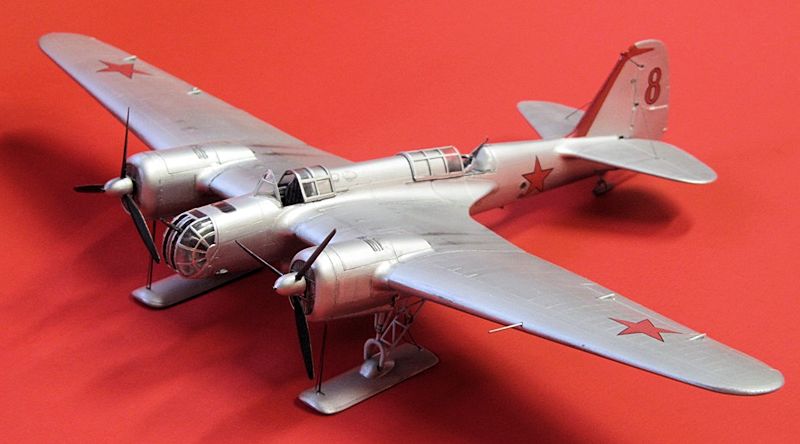
ICM 1/72 SB-2 M100A
| KIT #: | 72162 |
| PRICE: | $28.00 |
| DECALS: | Four options |
| REVIEWER: | Ryan Grosswiler |
| NOTES: |

| HISTORY |
Designed to meet an ambitious 1934 Soviet specification, the Tupolev SB (for
Skorostnoy Bombardirovshchik:
High-Speed Bomber) must have looked positively futuristic compared to the
fabric-covered biplane fighters it faced at the time when the prototype was
rolled out later that year. And so it would prove to be. Yet such was the crazy
upward technological spiral going on in aviation that this marvel would be one
year an impressive performer, the next a vulnerable death-trap for its crews
when facing advanced, determined opposition in war.
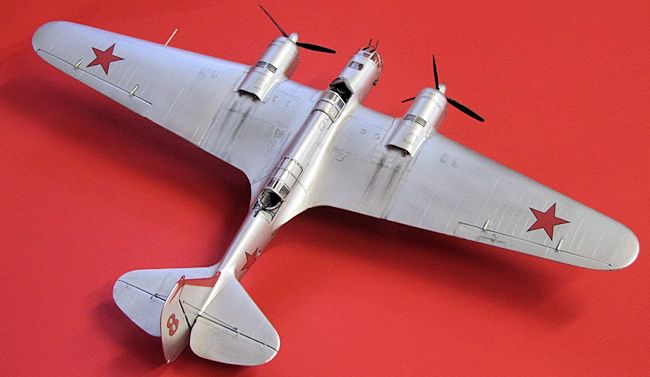 A contemporary of the American Martin B-10, the SB was a bit superior in
most aspects to the Western aircraft. Coming off the success of their fixed-gear
corrugated-skin TB series of bombers (themselves contemporaries of
the famous American Ford Trimotor),
the ever-foul-mouthed Andrei Tupolev and
his prim deputy Alexander Archangelskii drew
up a clean, stressed-skin retractable-gear
bomber—in that decade's common twin-engine/three-seat formula—and the resulting
aircraft became the USSR’s first real export success. Over six thousand were
built, seeing service from Spain to China and at some point pretty much
everywhere in between. Used properly at higher altitudes, it was an unqualified
success in the hands of Republican pilots in the Spanish Civil
War. The nearly-uncatchable aircraft were also noted in 1939 by the
Japanese fighting the Soviets at Kalkin-Gol
(a major
border spat started when a Mongolian cavalry unit crossed the wrong river to
graze its horses). Impressed, they created their own equivalent in the form of
the Kawasaki Ki-48.
A contemporary of the American Martin B-10, the SB was a bit superior in
most aspects to the Western aircraft. Coming off the success of their fixed-gear
corrugated-skin TB series of bombers (themselves contemporaries of
the famous American Ford Trimotor),
the ever-foul-mouthed Andrei Tupolev and
his prim deputy Alexander Archangelskii drew
up a clean, stressed-skin retractable-gear
bomber—in that decade's common twin-engine/three-seat formula—and the resulting
aircraft became the USSR’s first real export success. Over six thousand were
built, seeing service from Spain to China and at some point pretty much
everywhere in between. Used properly at higher altitudes, it was an unqualified
success in the hands of Republican pilots in the Spanish Civil
War. The nearly-uncatchable aircraft were also noted in 1939 by the
Japanese fighting the Soviets at Kalkin-Gol
(a major
border spat started when a Mongolian cavalry unit crossed the wrong river to
graze its horses). Impressed, they created their own equivalent in the form of
the Kawasaki Ki-48.
However, the technology curve and world politics were changing rapidly. Fast
monoplane fighter had succeeded the biplane, and these local brush fires and
territory grabs were about to ignite into ‘World War II proper’. The fortunes of
the SB would decline accordingly later that year when Stalin decided to practice
a bit of Realpolitik with his neighbor to the northwest (though official Russian
sources tell the story quite differently)
in a massive invasion of Finland which became the
well-known Winter
War. Here, the hapless SBs, now slowed down by clumsy fixed skis for use
from their snowbound forward bases, were also forced below low cloud for their
bomb runs where this combination left them vulnerable to everything down to and
including spit wads fired at them by the irate Finns. Some 100 were lost
in four months of fighting. Recognized by the USSR as obsolete by the end of
that costly operation and due for replacement by several new bomber types (being
directly succeeded by the Petlyakov Pe-2),
the frighteningly repressive atmosphere of Stalin’s USSR nonetheless ensured
that the old SB was still the backbone of the VVS bomber force by the time
Hitler turned his malevolent attention eastward in June of 1941. The vast
majority of the operational SBs (and just about the entire Soviet airframe
inventory, for that matter) were destroyed on the ground in the first three days
of the Nazi invasion.
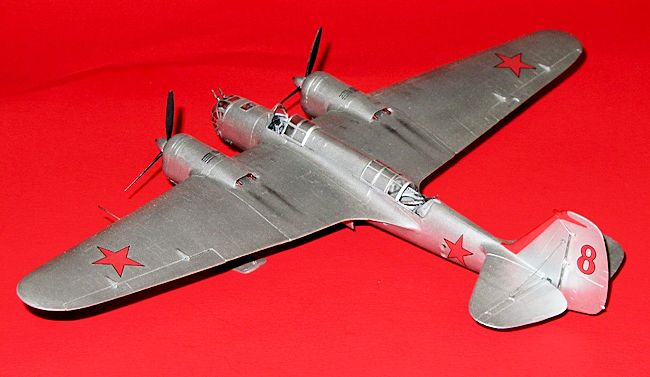 By now, Stalin’s purges had been through most of their cycle as well. Andrei
Tupolev was in prison. Archangelskii, apparently inconspicuous enough to
miss the swing of the scythe, had attempted to prolong the life of the SB
design in his absence with an engine & defensive armament upgrade, then finally
a major redesign in the form of the aerodynamically cleaned-up Archangelskii
Ar-2, both of which proved a dead end nonetheless. Tupolev would emerge from
prison mid-war with an apology from Stalin—the only person to receive such an
‘honor’—and a clean-sheet-of-paper design called the Tu-2 (the Soviet
counterpart to the Douglas A-26), launching an uninterrupted line of highly
successful and snazzy-looking bomber and transport aircraft to come the Cold War
decades ahead. But that’s another story….
By now, Stalin’s purges had been through most of their cycle as well. Andrei
Tupolev was in prison. Archangelskii, apparently inconspicuous enough to
miss the swing of the scythe, had attempted to prolong the life of the SB
design in his absence with an engine & defensive armament upgrade, then finally
a major redesign in the form of the aerodynamically cleaned-up Archangelskii
Ar-2, both of which proved a dead end nonetheless. Tupolev would emerge from
prison mid-war with an apology from Stalin—the only person to receive such an
‘honor’—and a clean-sheet-of-paper design called the Tu-2 (the Soviet
counterpart to the Douglas A-26), launching an uninterrupted line of highly
successful and snazzy-looking bomber and transport aircraft to come the Cold War
decades ahead. But that’s another story….
Meanwhile, the Finns, displaying the Scandinavian trait of efficient frugality, had repaired some of the many shot down on their soil, purchased others captured by the Germans in the invasion, and used the remaining wrecks as a spares source. These equipped Finnish bomber and anti-shipping squadrons, and it’s a testament to how marginal equipment can remain potent weaponry (if good training and thoughtful deployment are used) that they remained in successful front-line use through the end of the war. The USSR kept their own survivors for some time as night bombers and for training, a few dozen of which again saw action in Manchuria against a very depleted Japan in 1945. One airframe survives today, retrieved from Siberia in the late ‘70s as a wreck, restored with a slightly inaccurate nose, then tossed outside into the elements by the staff at the Monino Central Air Force museum, near Moscow.
| THE KIT |
For many years, the only kit of this important aircraft in any scale was the
old Frog molding, available for most of the 1980s in its Soviet Novo boxing.
I built that kit for a collector around 1995, and it was overall fairly accurate
in size and shape but marred by some thick trailing edges and sloppy raised
surface detail and clear parts. Falcon produced a vac-form canopy
set (as part of Set #24) which effectively fixed the latter problem. The MPM group
first made a 1/48th vacuform kit
around 1989 (never
have seen that one built), then a pair of 1/72 injection-molded releases about
1998. These were typical of
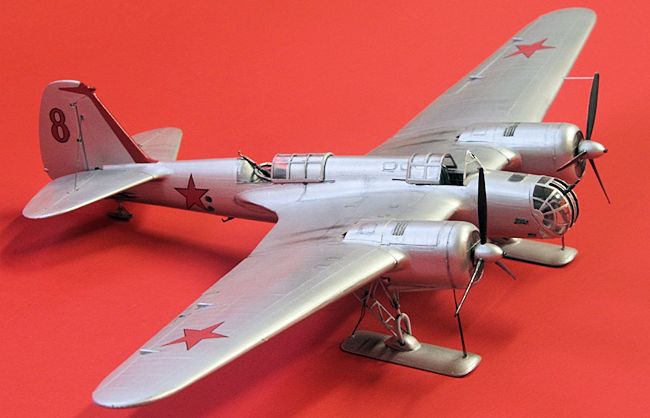 this firm’s early low-pressure-injection efforts:
accurate in dimension and possessed of some finely recessed panel
lines, but disappointing regarding shape fidelity (meaning that it doesn’t look quite
right) and overall finesse.
this firm’s early low-pressure-injection efforts:
accurate in dimension and possessed of some finely recessed panel
lines, but disappointing regarding shape fidelity (meaning that it doesn’t look quite
right) and overall finesse.
The Ukrainian firm ICM came to the rescue in late 2007 with the gem reviewed here. Six sprues of grey and one clear plastic with some of the most realistic stressed-skin surface detail ever put into an aircraft kit--though it won’t be to everyone’s taste as it is not the dull recessed style put out by the likes of Hasegawa and Tamiya. Parts count totals about 180. Control surfaces are separate, and options abound, including wheels or skis, two- or three-bladed props, choice of gun types and windshields, single and dual-gun noses, and a good supply of nicely-rendered FAB-100, -250, and -500 bombs. There’s a little flash here and there. The only flaw on my sample was that main wheels were short-shot, forcing an early decision to go with the fixed-ski version. The sprue layout suggests the possibility of the later M-103 version; not announced by ICM to date.
| CONSTRUCTION |
Quite a bit of mold-release agent gummed up the sprues, necessitating a good
scrub with some potent dish detergent followed by an overnight air-dry. I
started by removing the upper and lower forward fuselage/wing center section
parts and the two rear fuselage halves. These were test-fitted for potential
assembly problems.
The instructions outline a logical assembly sequence with the kit being
engineered to an unusual breakdown that closely mimics the real SB’s
manufacturing subassemblies. I closely followed them. Patient dry-fitting, some
very light block-sanding of mating surfaces, and thinking a few steps ahead paid
off here: I used only Testor’s liquid cement for assembly and zero
filler. Mikhail Maslov’s excellent “Tupolev SB” was my main reference
throughout, with the Squadron title useful for some additional details (mainly
of the bomb bay). Corrections and improvements along the way included:
1.
Interior detail:
separate cockpit sidewalls and an instrument panel are included, but are
mysteriously blank. I added bits of stretched sprue and
disks from my Waldron Punch and Die set to fix this, using interior shots from
the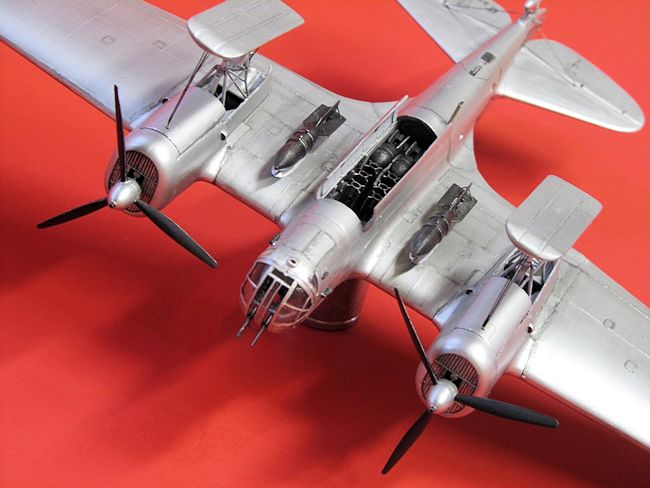 Maslov book
as a guide. This won’t be necessary if you pose the canopies shut (see below).
Maslov book
as a guide. This won’t be necessary if you pose the canopies shut (see below).
2.
Canopies posed open: as
molded, they are separate but way too thick for realistic ‘sit’ when shown slid
open on the fuselage (the Falcon canopies for the Frog kit won’t work, either: I
tried). Carefully, gingerly, I spent about .5 hour filing away their interior
surfaces with a Perma-Grit
rod and test-fitting until they looked right in the open position, then
another .5 hour polishing up their interior surfaces. Real
SBs, by the way, used a celluloid material for their glazing which tinted with a
little time to a slight brownish-yellow.
3.
Wing center-section trailing edge straightened:
(I might catch some flak on this one) molded as a slight curve, numerous photos
show a straight line when viewed end-on. This was achieved with a few passes of
a file to match the Maslov plan view, followed by more on the mating surfaces to
thin the trailing edge back down before the parts were joined.
4.
New prop shafts: made
from brass rod and tube to replace the jiggly kit
provision.
5.
Stance shortened: When
fitting the landing gear and skis, I noticed the model sitting too high compared
to photos. I couldn’t track down the specific problem, so sanded the skis
thinner (shortening them ¼” lengthwise and reshaping while I was at it to match
photos and the Maslov drawings),
and slightly shortened the wheel forks to take off a total of about 3/16” of
main gear height.
6.
Misc. detail: Exhaust
stacks drilled out. Tension and retention lines on the main skis, bracing wires
on the tail from steel wire. I kept the front gun slots open, as this simplified
things and photographic evidence shows the sliding covers were often left off,
even in winter. Some riveting and panel detail on the bomb-bay doors and wheel
well interiors was drawn in with a soft pencil based on photos in the Squadron
book. I also ‘hung’ an unlikely huge bomb load, figuring that this was an
aircraft based near the front where fuel would be sacrificed for more ordinance
brought to bear on the target.
Canopies were masked with an excellent but long-gone product called Miracle Mask (the only liquid mask of many I’ve tried that actually worked), but Eduard has since come out with a masking set (product #CX 122) for the intricate framing of this model.
| COLORS & MARKINGS |
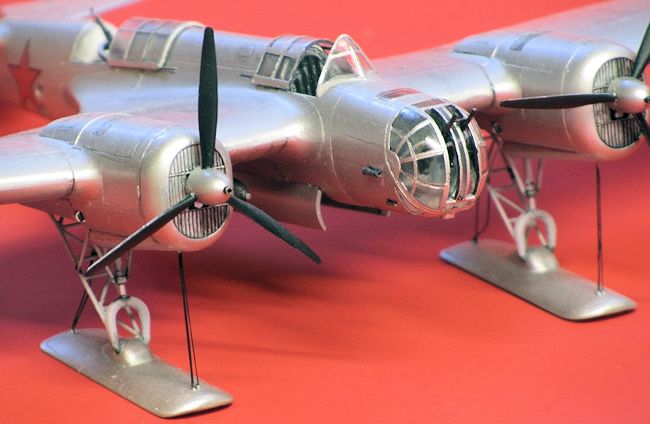 Super simple! I selected silver ‘Red 8’ from the four decal options given. This
aircraft is depicted in the Maslov and
Squadron-Signal books as both photo and illustration, with the Squadron book
showing the “8” as blue. Soviet bombers deployed in the Winter War used two
basic finishes: an overall light grey (as depicted on the box-art aircraft) and
a second which to my eye looks like silver dope. I primed the model with
Future floor coating,
then sprayed on Testor’s non-buffing
Aluminum
Metalizer,
which
depicted this doping very effectively. Kit decals were used, being rather stiff
and matt and barely useable, but ended up looking okay once applied (I’d replace
the red stars with aftermarket offerings if I were to do it again). Weathering
was kept to a minimum, as I felt that use in that boreal winter environment
would keep things fairly sterile, and only applied a light enamel wash around
engine and underwing details and some light pastel exhaust smudges. This was all
sealed in with some old Aeromaster Semi-matt clear enamel I
needed to use up.
Super simple! I selected silver ‘Red 8’ from the four decal options given. This
aircraft is depicted in the Maslov and
Squadron-Signal books as both photo and illustration, with the Squadron book
showing the “8” as blue. Soviet bombers deployed in the Winter War used two
basic finishes: an overall light grey (as depicted on the box-art aircraft) and
a second which to my eye looks like silver dope. I primed the model with
Future floor coating,
then sprayed on Testor’s non-buffing
Aluminum
Metalizer,
which
depicted this doping very effectively. Kit decals were used, being rather stiff
and matt and barely useable, but ended up looking okay once applied (I’d replace
the red stars with aftermarket offerings if I were to do it again). Weathering
was kept to a minimum, as I felt that use in that boreal winter environment
would keep things fairly sterile, and only applied a light enamel wash around
engine and underwing details and some light pastel exhaust smudges. This was all
sealed in with some old Aeromaster Semi-matt clear enamel I
needed to use up.
| CONCLUSIONS |
A most satisfying project…accurately depicts the prototype about all aspects,
and just enough challenge for some intriguing (but not frustrating) modeling.
The build took about 20 hours, with about 3 (!) for all painting and
finishing. Notably, there was never a moment I wasn’t enjoying the project
and I’ve never put so little effort into a finish to receive such a striking
result. There are no actual fit problems, but some careful dry-fitting and light
preparation of mating surfaces allow this. Highly recommended for
modelers who’ve built a few multi-engine types or
those looking for a stepping stone project into the world
of ‘other-than-shake-and-bake’ kits...
| REFERENCES |
Mikhail Maslov, Tupolev SB: Soviet
High Speed Bomber
Hans-Henri Stapfer, Tupolev SB in
action (Squadron-Signal Aircraft #194)
Bill Gunston, The
Osprey Encyclopedia of Russian Aircraft 1875-1995
October 2
If you would like your product reviewed fairly and fairly quickly, please contact the editor or see other details in the Note to Contributors.
Back to the Review Index Page 2025